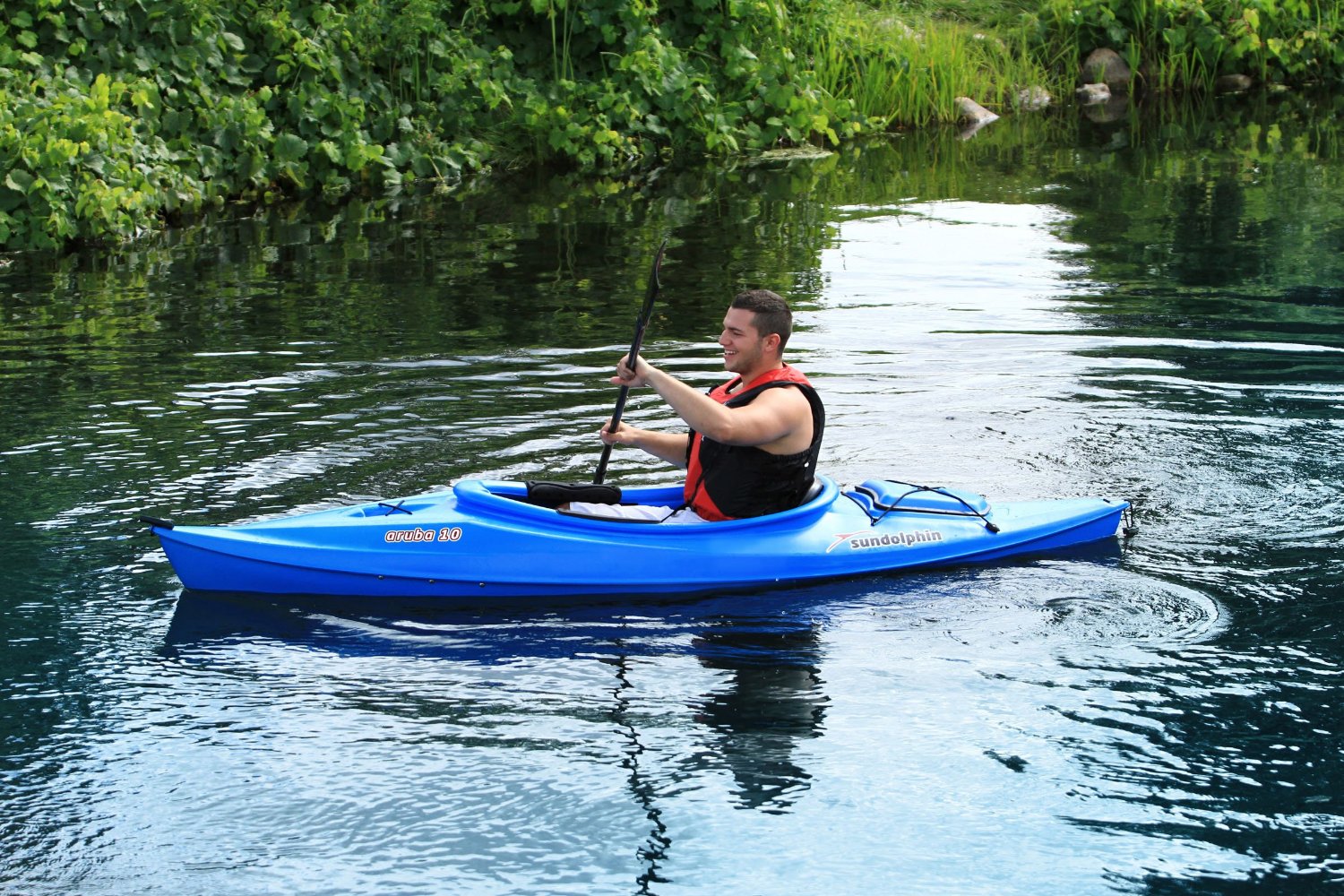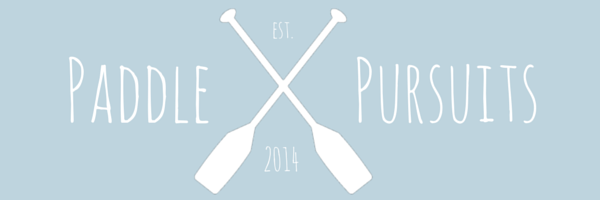
Kayaking is actually surprisingly simple to learn.
Paddling movements can be picked up fairly easily by even the most uncoordinated klutz, and most people will be able to master the basic strokes after a couple of sessions.
In this post, we’re going to teach you the three basic kayak paddling strokes you’ll need to have full control over your kayak and move your boat in any direction you want. Let’s get into it.
First Things First
While you’re learning how to kayak, you should stick to flat, shallow water until you are confident that you can control your kayak.
Paddling in waves and high wind is an essential skill, but one that should be learned after you’ve learned how to paddle a kayak correctly on calm water.

Learning how to kayak in sea conditions comes with experience
Paddling on the ocean, in an estuary, or class I or II rapids may look easy and not much different from calm lake conditions, but these water bodies require advanced skills and should only be attempted once you’ve reached a certain level of competency.
You should always take precautions when paddling in a new environment, or in rough weather, or when learning a new skill. Simple actions, such as bringing a friend along, telling people where you’re going, and always keeping within swimming distance of the shore, significantly reduce the likelihood of something going wrong.
Selecting the Right Paddle and Holding it the Right Way
Bad builders blame their tools. But when it comes to paddling efficiency, an incorrectly sized paddle could really be at fault.
Correct paddling technique starts with a properly fitted paddle. A good rule of thumb is to select a paddle around 30cm longer than your height.
It’s also important that you hold the paddle correctly. The spacing between hands is roughly just wider than a shoulders width apart.
The correct distance can be set by holding the middle of the paddle shaft on top of your head, and then sliding your hands until they’re at right angles. Keep your hands in that position when paddling.
Many paddles have a lump on the right-hand side of the shaft. This is known as a locating lump and is used to tell which way the blades are positioned without looking at the paddle. It is particularly useful when you’re navigating difficult stretches of water that need your full attention, or when you’re rolling a kayak.
If your paddle has a locating lump, your right hand (control hand) should hold onto it tightly and remain in the same position. Your left hand holds the paddle loosely, allowing it to rotate inside the hand, which makes it easy when stroking.
It’s common for paddles to have feathered blades, meaning that the angle of the blades is offset from one another. This stops the wind from catching the blade on the recovery stroke (the blade that is moving through the air and about to be submerged).
Always opt for a feathered blade given the choice. They are easier to use in windy conditions and lead to greater paddling efficiency.
Understanding the Technique
Kayaking may completely knacker you at first, but it gets much easier as you build your paddling muscles.
However, beginners also drain themselves unnecessarily due to adopting poor paddling technique.
Despite what you may think, proper paddling technique uses very little of your arm strength.
The best way to paddle a kayak is to use torque force and the larger muscles in your legs, torso, and shoulders.
Your arm muscles are weak compared to these muscles, and if you try to propel yourself using only your arms, you will tire quickly.

Be patient. Learning how to paddle a kayak correctly takes time
Utilise Footrests for Whole Body Paddling
Footrests make paddling much easier. They allow you to transfer the power from your legs and upper body into the paddle.
They aid with good technique and increase stability as you press your back into the seat for bracing.
You can push off the footrest and twist your upper body and still keep your centre of gravity in the middle of the boat.
It’s essential that you utilise footrests for efficient transfer of power, but to be able to do so, they have to be set at the right distance.
Adjust the footrests positions while on land so that your knees are slightly bent, and you can brace comfortably.
Some people like to have their knees pressing into the underside of the deck for added control when paddling a sit-in kayak, but that’s up to you.
The 3 Essential Paddling Strokes
There are many different strokes and techniques to learn for paddling.
We’re only going to cover the basic ones here to get you started, but you can upgrade your skills with advanced paddling courses if you wish.
Forward Stroke
The forward stroke is used for, you guessed it, moving the kayak forward.
To keep on course, your forward strokes need to be as parallel to the kayak as possible and your blade should stay close to the hull.
1. Holding the paddle roughly shoulders width apart, hold one arm straight out in front at eye level. Rotate your shoulders so that one arm is stretched out as far as possible, and your other shoulder is back. Your back should be straight, and you should be sitting tall.
2. Pull the outstretched arm down and plunge the paddle blade into the water. The blade should be fully submerged.
3. Using your shoulder, back, and hip muscles, pull the blade through the water towards you.
4. Your other hand should push the opposite end of the paddle forward simultaneously and repeat steps 1-3.
5. Pull the submerged blade out of the water when it reaches your hips.
Sweep Stroke
Keeping the kayak travelling in a straight line can be frustrating for new paddlers.
Sweep strokes are like forward strokes but use a wider angle that turns the kayak, allowing you to adjust your course incrementally, without losing momentum. They have a wide D-shape and are delivered with plenty of oomph.
1. Stretch forward as far as you can and plunge the blade into the water as close as possible to the kayak.
2. Pull the blade back in a wide arc using the shoulder and back muscles. The wider your arc, the greater the turning effect.
3. Your stroke should be much longer and resemble a semi-circle. It should start at the bow and finish at the stern.
4. Brace against the footrests or dig your knees into the inside of the hull to get added rotational movement.
Reverse Stroke
Mastering the reverse stroke will increase your manoeuvrability greatly. Reverse strokes allow you to stop and turn quickly, however, they use more energy, and you lose the speed you’ve built up.
1. Hold the paddle by your side with your elbow high and the blade behind your shoulder.
2. Push your arm down and dig the paddle blade into the water behind your hip.
3. Push the blade forward with your arm while pulling the opposite shoulder back. Essentially, it’s a small stroke in the reverse direction.
7 Paddling Technique Tips for Beginners
After applying what you’ve learned in this post, you’ll be equipped with everything you need to manoeuvre your kayak and have fun on the water.
To finish off, here’s a roundup of seven things to remember when you’re paddling.
- Avoid the Death Grip – Holding the paddle with a light grip allows you to remain flexible as you control your boat’s movements. It also reduces the chances of straining your muscles.
- Fine Course Adjustment – Sweep strokes can be very helpful when it comes to adjusting course without losing speed.
- Find Your Rhythm – Deep, forward paddling movements that are swift and rhythmic will give you added speed.
- Push Off Footrests – Set your footrests at the correct distance so that you can push off them and utilise your whole body for paddling.
- Put Your Body into It – Rotate your shoulders, torso, and hips with each stroke, but keep your centre of gravity in line with the central axis of the kayak. This is most easily achieved by consciously keeping your nose aligned with the middle of the boat
- Rock the Boat Baby – While in shallow water, rock your kayak deliberately to get a feel for how much movement you can have before the boat reaches tipping point.
- Submerge the Blade - Make sure that the blade is fully beneath the water’s surface with each stroke.
As an Amazon Associate, we earn from qualifying purchases. This is without any additional costs for the buyer but does support us in maintaining our website.



